#wettable
Explore tagged Tumblr posts
Text

New membrane technology could lead to more effective and efficient water purification systems
A team of NYU Abu Dhabi (NYUAD) researchers has developed a novel approach that utilizes microwave technology to more easily synthesize and fine-tune a new type of membrane which effectively purifies water from a wide range of contaminants. The membrane synthesis technique takes a few minutes, making it one of the fastest methods for creating covalent organic framework (COF) membranes. These membranes act as filters in devices designed to clean polluted water from specific contaminants, allowing its reuse in different applications—an important discovery at a time when efficient wastewater treatment becomes vital in a world threatened by water scarcity. The new type of dual-faced membrane, characterized by its unique superhydrophilic and near-hydrophobic surfaces, enables efficient removal of contaminants like oils and dyes from water. This dual functionality not only enhances the filtration process but also endows the membranes with strong antibacterial properties, crucial for long-term usability and effectiveness.
Read more.
#Materials Science#Science#Membranes#Clean water#Microwaves#Materials synthesis#Covalent organic framework#COF#Filters#New York University#Wettability
11 notes
·
View notes
Text
i may never get my forklift certification but surely once i get my commercial pesticide applicator's license the women will flock to me in droves
#i have driven a forklift btw. just not certified. osha don't @ me#anyway. ask me abt the difference between wettable powders and dry flowables
3 notes
·
View notes
Text
High-Precision Contact Angle Measurement Systems – Supplied by Orbit Research Associates
Explore a wide range of advanced contact angle measurement systems from KRÜSS, available through Orbit Research Associates. These instruments offer precise analysis of surface wetting, adhesion, and interfacial tension—ideal for research labs, coatings, and pharma applications.
✅ Supplied in India ✅ Expert technical support ✅ Accurate, reliable results for surface science
🔗 Visit now: https://www.orbitind.com/product-category/contact-angle-measurement-systems/
#ContactAngle#SurfaceAnalysis#KrussIndia#OrbitResearch#MaterialScience#SurfaceTension#Wettability#LaboratoryInstruments#contact angle measurement#contact angle meter#Contact angle Goniometer#Contact angle measurement system
1 note
·
View note
Text
🧪 Dynamic Surface Tension & CMC Analysis Using Advanced Tensiometers
Explore Surface Chemistry Like Never Before!

At Orbit Research, we offer advanced solutions for measuring surface tension, interfacial tension, and critical micelle concentration (CMC) — essential for surfactant-based formulations like cleaning agents 🧼, emulsifiers 🧴, and wetting agents 💧.
🔍 Tensiio – Precision Surface Tension Analyzer
Surface & interfacial tension via Ring, Plate, and Rod methods ⚗️
CMC determination for surfactant efficiency 📊
Oil aging tests (ASTM D971 / IEC 62961) 🛢️
Density measurements of liquids and solids ⚖️
⚡ Bubble Pressure Tensiometer (BPT) – For Dynamic Measurements
Fast single-point monitoring 🌊
Stand-alone mode with saved calibration data 💾
Ideal for quick surfactant content evaluation in real-time 📈
🔬 Whether you're in R&D, QC, or formulation testing, our instruments deliver accurate, reliable results — fast!
📩 Need more info? 🌐 www.orbitind.com ✉️ [email protected] 📞 011 – 42420858 | 45578977
#SurfaceTension#Tensiometer#LabInstruments#Surfactants#CMCAnalysis#BubblePressureTensiometer#ContactAngle#InterfacialTension#OrbitResearch#SurfaceTesting#Wettability#LabEquipment#IndustrialQC#ScienceTech#Dewetting#MaterialScience
0 notes
Video
youtube
Beautiful Anhinga ( Anhinga melanogaster/Oriental Darter /Snake Bird in...
#youtube#Bird#Birds#Anhinga#Oriental Darter#Snake Bird#Anhinga melanigaster#Kukkarahalli Lake Mysore#Kukkarahalli Kere Mysore#wettable Feathers#wetlands#Freshwater Biird
0 notes
Text

Individual 100ml bottles of Dyne Testing Inks for surface energy testing. This ink is formulated to provide accurate and reliable results when testing the surface energy of various materials.
#dyne#testing#inks#surfaceenergy#adhesion#wettability#coating#substrate#surfacepreparation#qualitycontrol#manufacturing#industrial#printing#packaging#plastics#adhesive#inktesting#surfacechemistry#surfaceanalysis#surfaceproperties
0 notes
Text

Anhingas are water birds found in the warmer parts of the Americas, including Florida, where they are year-round residents. Their range extends from coastal South Carolina westward to Texas and Mexico, and as far south as Argentina.
Appearance and Hunting:
They have a long, slender neck and a straight, pointed bill, which they use to spear fish and other small prey underwater.
"Snakebird" Name Origin:
The name "snakebird" comes from their unique swimming style, where only their head and neck are visible above the water, resembling a snake ready to strike.
Feathers and Drying:
Like cormorants, Anhingas have wettable feathers and are often seen perched with their wings spread open to dry after diving for food.
25 notes
·
View notes
Note
I love your art so much!!! I've also been starting to paint with gouache, and I'd love to know a little more about your process! What kind of paints do you use, do you sketch first or start with paint, do you paint in layers over several day or all at once?
Hi and thank you! I hope you don't mind me answering this publicly and apologies for length, but:
MY ART PROCESS!
Supplies: I use winsor and newton gouache and arches cold press paper blocks, usually 140 lbs (the lime green ones) and sometimes 300 lbs (the teal green ones). Even though this paper comes pre-stretched in blocks, I actually take the sheets off and stretch them myself because I've found arches' glue isn't as strong as it used to be. This is how you get watercolor paper to lay flat! I recommend youtubing some videos on how to do it -- there's a lot of great tutorials out there. Also, I use princeton brushes, and kraft paper tape and these boards to stretch my paper. (these aren't affiliate links, I just shop at blick)
A word about art supplies: these are the exact tools I use but everyone uses supplies differently and two people with the exact same supplies might get different results! A lot of it is about what works for you and what you like, so I always suggest that gouache/watercolor beginners just buy a few tubes from a couple of different paint companies and some small pieces of paper from different manufacturers to see what you like. Just changing one ingredient in the above has created massively different results for me, but maybe that'll end up being something you'd like! The first step in learning a new medium imo is to play. Just have fun!
ALSO: gouache isn't super light permanent, check your tubes for which ones hold up to sunlight. Here is winsor and newton's color chart explaining which ones will fade when exposed to sunlight -- all manufacturers will give you this. I only use the colors rated A and AA, and I still frame my pieces with UV glass just to be safe. Not all gouache is re-wettable, but winsor and newton is. I just put it in my palettes and refill my palettes if it runs low. AND SOME PAINT IS TOXIC. A lot of paints have cadmium and cobalt in them. I don't use any of the toxic colors, but if you do, make sure you don't eat while working and wash your hands thoroughly afterwards. This information is also usually available on manufacturer's websites. As more people are rejecting cadmium paint, you'll see more tubes labeled things like cadmium-free yellow. This is why. More artists should be aware that their tools can be dangerous. You don't need that many tubes of paint to begin, just a warm and cool red, warm and cool yellow, warm and cool blue, white and black. I have around 50 colors and use 20 regularly. I always mix all my colors myself, and never use straight tube paint. Most of my colors have about 5-6 different tube colors mixed together. If you use re-wettable paint a tube of paint will last you years; even as a professional I only buy new paints every 5 years or so.
Process: I ALWAYS start with a sketch first. Not everyone has to, but because I do illustration work -- where sometimes a client gets input on a drawing -- I always do a lot of preliminary work before I even begin to paint. At this point, even my personal work usually involves the exact same process:
I start with a 3" or so thumbnail that I scan (left; I traced it quickly digtally for clarity to myself here) and then either clean up digitally or print out and clean up traditionally with tracing paper (right):
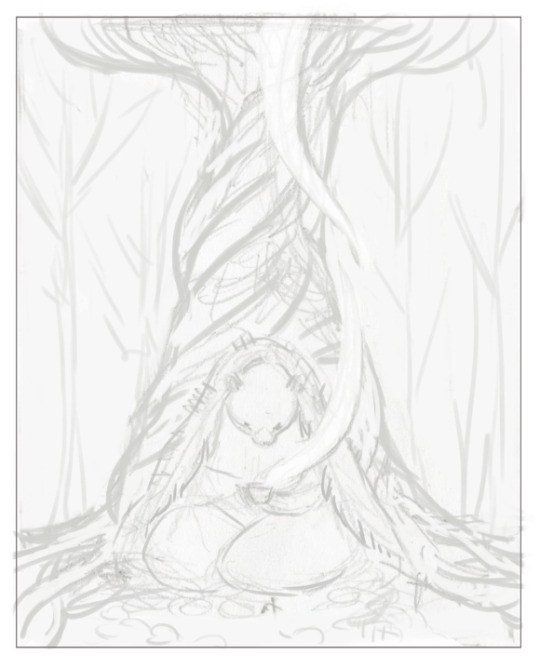

Then I scan the cleaned sketch in and color rough it digitally (left, this was for a gallery show, so no one had to approve my color roughs, so it's messy!) then I transfer my sketch to my paper (with either carbon transfer paper or a light table), stretch my paper, and paint (right):
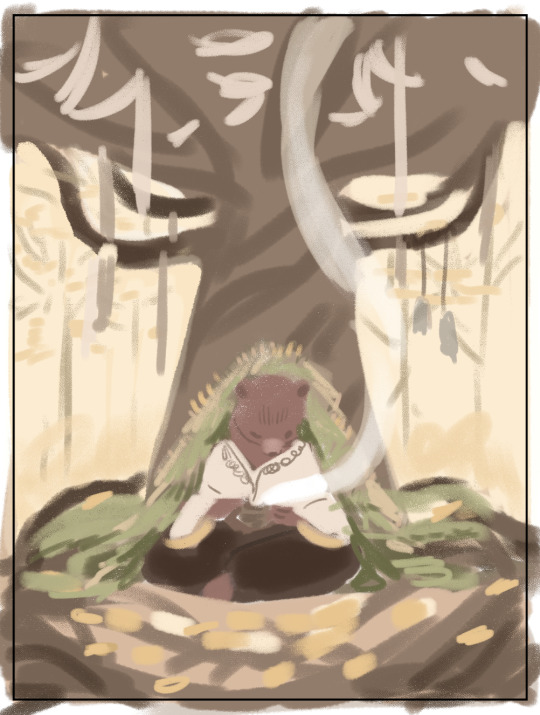
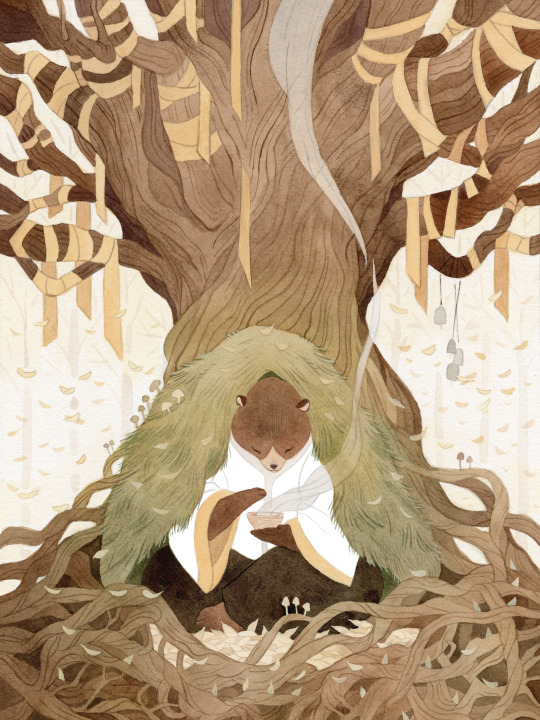
I obviously changed my mind about the color of the ribbon in the trees, ha, and made everything a lot more vibrant. The benefit again of gallery work is no pre-approval!
You are correct, I paint in a series of washes, going from lightest to darkest, where I apply the same color beneath all shapes that are the same warmth (cools under all upcoming cools, warms under all upcoming warms). I paint a piece usually in one or two days, depending on complexity. I didn't take pictures of the above painting, but here's a different painting to show you a little bit what I mean:
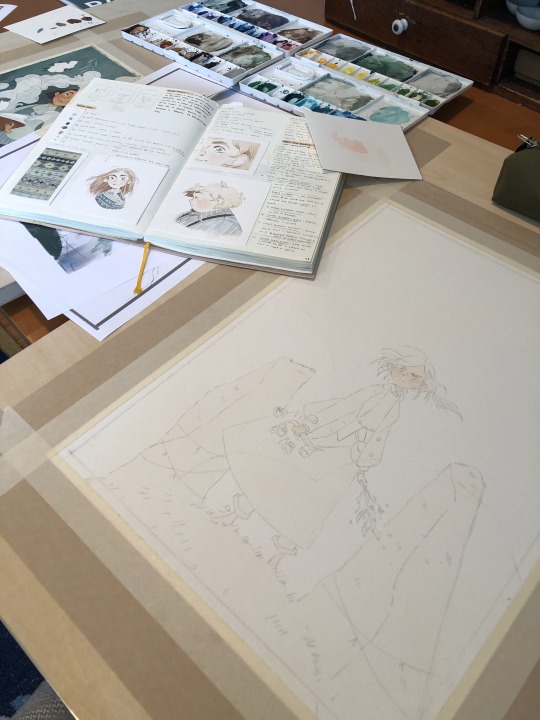
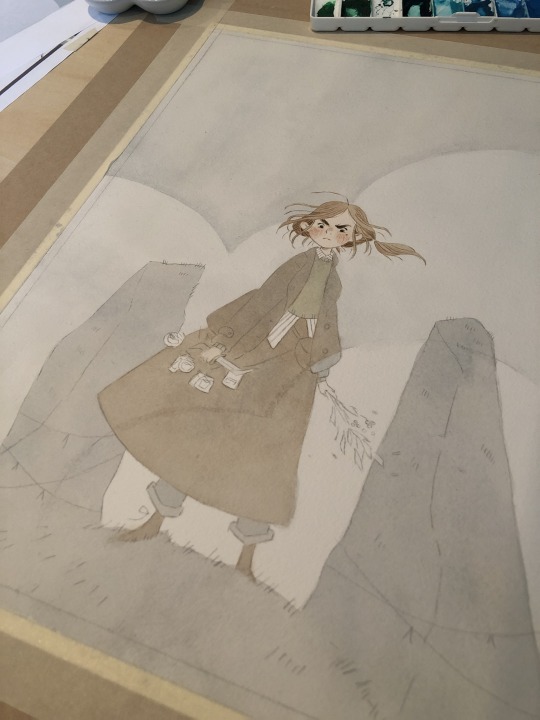
I painted the peach color under everything (and twice for skin tones), and the gray color of the sky under everything that would be grayish (the rocks, trees, her pants, her skirt, and coat). I do this to stop me from getting darker lines where two different colors butt up against each other, and also for color harmony. I have step by step photos of this in my process stories highlight on my instagram; also check my FAQ and tip highlights for more info on all this stuff. Most pieces take around 25-30 washes before I start adding in the details (sometimes I add in face details early though because if I mess those up it's not worth finishing the rest of the painting! 😅)
All this might seem like a lot of work (...it is) but I do it so that I can show clients previews of the final piece and so I don't have to repaint the finals. I also used to pre-test all of my washes on scrap paper like this:
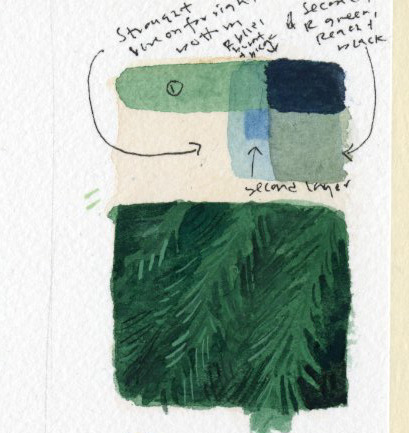
I still recommend doing this if you're just beginning! But at this point I only do it when testing techniques because I know my paints really well. (the above was my test for the pine boughs in this piece)
Painting by far is the longest part of the process, so I do more work up front to not have to do it twice. Every piece takes about 6-24 hrs of actual work time to produce. Stretching watercolor paper takes about 24 hrs to dry, and because I sell most of my originals in galleries, they need to be flawless, so planning ahead is useful and in the end saves me time.
And to conclude this novel of an explanation, don't be overwhelmed by all the information I've given you! I put it here so that people at various stages of their artistic journey can maybe find something useful in it. But seriously, the first step to learning how to paint whether it's traditionally or digitally is just to have fun. Try it out, see what's working and what isn't, and then try to solve specific issues that you're struggling with. I've been doing this for a loooooong time at this point, but here's my first watercolor piece from when I was re-teaching myself how to paint traditionally nine years ago:
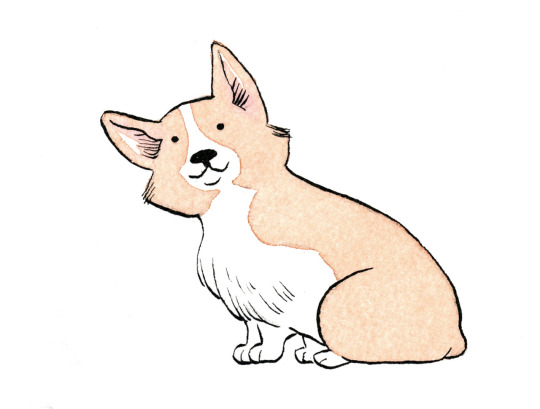
Obviously, I was destined for greatness. Ha, yeah, no. If you scroll back through my tumblr archive, you can see me learning how to use these paints in real time. And keep in mind that I'd been working digitally for years before then, and years before that where I didn't post my work online at all.
So for anyone who needs to hear it: there's no such thing as talent, just hard work, patience, and trying again and again and again...and sometimes again. What I do is a skill and anyone can learn it. Sometimes, progress is slow. I'm 38. I only really feel like my art was half-way decent starting a few years ago, but I've been making art my entire life, and I went to art school at 18. 20 years later I'm kind of figuring it out.
The best advice I can give, whether it's about art or not, is find the thing you love so much that you'll keep at it even when you suck at it, because most skills you'll suck at to begin with -- and perhaps for a long time. I sucked at art for yeeeaaaaarrrrs. On top of the usual learning curve, I struggled with fine motor control and dexterity. But I loved it so much I kept trying every time I failed. If I can do it, so can all of you, no matter what stage of art you're at now, and no matter how old you are.
Anyway, thank you to those still reading this deep in. I wish you all the best on your artistic journey. Art can kick your butt sometimes, but it's also pretty dang rewarding 💛
543 notes
·
View notes
Note
Hello! If you are OK with more WFI asks then I have random thoughts. Such as, how would your double mutated grimlen do with water and bathing. I know some birds give themselves "dust baths" for their feathers but I think you mentioned on another post that Donnie would remain somewhat aquatic. I can only imagine how heavy all those feathers would be wet. Or is it like certain diving birds that have some what water repellent feathers? Feel free to ignore my rambling thoughts. They definitely didn't spawn eating breakfast and watching a bird land in a birdbath. Again, love all of this thank you so much for taking the time to share with all of us :)
How does he do with water, you say?!
HE LOVES IT.

(I got carried away with this quick messy doodle for the ask so uh, here ya go lmao)
I. LOVE. ASKS. For water and bathing? Hes still great with water, the second mutation probably made it even more fun to swim since he can now dart further and faster with wings propelling him. Idk about the manticore he got the dna from, but Donnies wings are based on a Cormorants so for any bird-like traits Donnie may have, theyll be inspired by a Cormorant :)
As for bathing? (Thisll kind of answer part of another ask thats queued) he absolutely prefers to use water, a dust bath is a literal sensory nightmare and for him- itd probably feel like having itchy sand in places you didnt even know existed xD
Did some research about Cormorant feathers since im a little rusty on that hyperfixation, but their feathers are "not water-repellent, but 'wettable.'", which makes them much more efficient underwater <- Same goes for WFI!Donnies feathers. Theyd also definitely have added weight when wet, and hed have difficulty flying unless they dried out somewhat first.
He doesnt realize quite how lucky he is to have traits built for all terrains >:)
#cimmerian1275#tmnt#rottmnt#donnie#donatello#double mutated donatello#double mutated donnie#WFI AU#wait for it au#WFI donnie#WFI ask#gasp an ask#cimmers art#digital art
31 notes
·
View notes
Text
This method represents an important step in tailored surface engineering. By enabling precise control over surface wettability and thermal properties, we are opening new doors for scalable manufacturing of advanced heat transfer surfaces.
7 notes
·
View notes
Text
An international team of engineers has developed an innovative, scalable method for creating topography-patterned aluminum surfaces, enhancing liquid transport properties critical for applications in electronics cooling, self-cleaning technologies and anti-icing systems. The research, published recently in Langmuir and conducted by groups at Rice University and the University of Edinburgh as part of the Rice-Edinburgh Strategic Collaboration Awards program, demonstrates how cost-effective vinyl masking techniques can produce surfaces with high-resolution wettability contrast, paving the way for improved phase-change heat transfer applications. The research team developed a novel technique using blade-cut vinyl masking and commercially available lacquer resin combined with scalable physical and chemical surface treatments to create patterned aluminum surfaces. These surfaces exhibit distinct wettability contrasts, significantly improving the droplet shedding during condensation. The patterns, with feature sizes as small as 1.5 mm, offer a range of wettability behaviors -- from superhydrophobic to hydrophilic -- depending on the treatment.
Read more.
14 notes
·
View notes
Note
"Wet feathers can prove disastrous in cold weather. But with the wet winter weather, how do birds stay dry? The answer lies in the oil-producing glands birds have. They preen to coat their feathers in this oil to waterproof and insulate their down feathers."
"In addition to providing the ability to fly, feathers help to insulate and waterproof a bird’s delicate body."
"...deep water would cause the birds to become soaked, which would prevent them from flying properly. This is one of the reasons birds prefer baths that are shallow – they splash around until their bodies are just wet enough – and opt for taking many short baths rather than one long bath."
"The majority of bird species will drown if they fall into deep water, as they lack the mechanisms required to survive, most notably their feathers are not waterproof and would quickly become sodden, dragging them down, their wings aren’t the right shape or be strong enough to use them as paddles, and their legs and feet lack the structure and strength to help them out."
"Most bird feathers are somewhat water resistant, and in light rain, you may see birds fluffed up, just as they would in a dry cold....Heavy rain calls for a different tactic. Fluffing up your feathers keeps you warm, but if the rain is heavy enough, water will get in between your fluffed-up feathers and chill you faster. Instead, in heavy rains birds sleek down their feathers to reduce their wettability."
"Most birds are mostly waterproof. Their feathers, combined with oil from preen glands, keep them pretty watertight."
This is some information from different articles I found. If I'm understanding it correctly, many birds are somewhat water resistant but would still drown in deep water due to not being waterproof enough; feather, wing, and foot shape; etc? So maybe your idea could still work somewhat?
Gosh idk when you sent this but thank you for this information! In fact, thanks everyone who shared thoughts on this!! I’m glad everyone is sharing scientific information that I can still keep for my hc >:))
#very interesting stuff!#I think I knew that they preened their feathers for the oil#but I don’t think I knew it was for water resistance#asks#sorry for what I’m gonna do to you Kass#but yeah thanks everyone this made me happy to know :))#nothings worse than having an AWESOME headcanon that gets disproven#so I appreciate it
10 notes
·
View notes
Text
Froth Flotation Chemicals Market Size, Anticipating Growth Prospects from 2032
The global froth flotation chemicals market was valued at USD 1.8 billion in 2022 and is projected to exceed USD 2.4 billion by 2032, registering a CAGR of 2.4% over the forecast period.
Key factors driving market growth include the increasing demand for base metals such as steel, aluminum, and iron, along with the rising popularity of precious metals like platinum, gold, and silver. Additionally, the expansion of mining activities worldwide is expected to significantly boost the demand for froth flotation chemicals.
This heightened mining activity is anticipated to contribute a gain of 178 basis points (BPS) to the market during the forecast period from 2022 to 2032, underscoring the sector's positive outlook.
𝐅𝐨𝐫 𝐦𝐨𝐫𝐞 𝐢𝐧𝐬𝐢𝐠𝐡𝐭𝐬 𝐢𝐧𝐭𝐨 𝐭𝐡𝐞 𝐌𝐚𝐫𝐤𝐞𝐭, 𝐑𝐞𝐪𝐮𝐞𝐬𝐭 𝐚 𝐒𝐚𝐦𝐩𝐥𝐞 𝐨𝐟 𝐭𝐡𝐢𝐬 𝐑𝐞𝐩𝐨𝐫𝐭: https://www.factmr.com/connectus/sample?flag=S&rep_id=5372
Region-wise Insights
North America holds the largest share of the froth flotation chemicals market, accounting for 25.8% of the global market. The region is anticipated to grow at a CAGR of 2.6% during the forecast period. This growth is primarily driven by significant investments in industrialization, which have increased the demand for metals and minerals, thereby supporting market expansion.
Furthermore, the adoption of eco-friendly product offerings and advancements in addressing ore quality issues are positively influencing the use of froth flotation chemicals. These factors are expected to sustain market demand in the coming years.
However, stringent regulations, evolving mining policies, and a changing regulatory landscape are potential challenges that may hinder market growth in North America during the forecast period.
Category-wise Insights
The froth flotation chemicals market, under the reagent type segment, is categorized into collectors, frothers, modifiers, and others. Among these, the collectors segment dominates the market, accounting for 36.7% of the market share, and is projected to grow at a CAGR of 3.2% during the forecast period. The leading position of collectors is attributed to their ability to enhance the wettability of minerals, facilitate the separation of mixtures, and reduce mixture stability, making them critical in flotation processes.
The frothers and modifiers segments follow as key contributors, holding 26.4% and 21.3% of the market share, respectively. These segments are expected to grow at CAGRs of 2.8% and 2.4% from 2022 to 2032. Their steady growth is driven by their crucial roles in stabilizing froth formation and altering the pH or surface properties of materials to optimize flotation efficiency.
Competitive Landscape
The global froth flotation chemicals market is highly fragmented and competitive, characterized by the presence of numerous domestic and regional players. Key companies employ various strategies, including mergers and acquisitions, expansions, collaborations, and partnerships, to strengthen their market position.
New product development is also a core strategy among leading manufacturers, enabling them to enhance their market presence and meet evolving consumer demands. These efforts have significantly contributed to the advancement of froth flotation chemicals.
Fact.MR’s recent report offers comprehensive insights into price points of key manufacturers, regional sales growth, production capacity, and technological advancements shaping the froth flotation chemicals market.
Key developments in the market include:
Air Products and Chemicals Inc. acquired five operational hydrogen plants from PBF Energy in 2020, ensuring a long-term hydrogen supply to refineries. In 2021, it acquired full ownership of China Shenhua Coal to Liquid and Chemical Co. Ltd, a joint venture with China Energy Group. This acquisition strengthens its gasification technology portfolio and enhances its engineering and technical capabilities in China.
Huntsman Corporation acquired CVC Thermoset Specialties in 2020. This move expands its specialty chemicals portfolio and bolsters its market presence in North America, Europe, and Asia, supporting the global growth of its product range.
𝐆𝐞𝐭 𝐂𝐮𝐬𝐭𝐨𝐦𝐢𝐳𝐚𝐭𝐢𝐨𝐧 𝐨𝐧 𝐭𝐡𝐢𝐬 𝐑𝐞𝐩𝐨𝐫𝐭 𝐟𝐨𝐫 𝐒𝐩𝐞𝐜𝐢𝐟𝐢𝐜 𝐑𝐞𝐬𝐞𝐚𝐫𝐜𝐡 𝐒𝐨𝐥𝐮𝐭𝐢𝐨𝐧𝐬: https://www.factmr.com/connectus/sample?flag=RC&rep_id=5372
Global Froth Flotation Chemicals Market by Category
By Reagent Type:
Collectors
Xanthanate Salts
Fatty Acids
Others
Frothers
Alcohols
Polyglycol Ethers
Methyl Isobutyl Carbinol
Modifiers
pH Modifiers
Depressants
Activators
Deactivators
Others
By End-User:
Mining Industry
Paper and Pulp Industry
Water Treatment
Others
By Region:
North America
Latin America
Europe
East Asia
South Asia & Oceania
MEA
𝐂𝐨𝐧𝐭𝐚𝐜𝐭:
US Sales Office 11140 Rockville Pike Suite 400 Rockville, MD 20852 United States Tel: +1 (628) 251-1583, +353-1-4434-232 Email: [email protected]
1 note
·
View note
Video
youtube
Awesome Snake Bird / Oriental Darter @ Kukkarahalli Lake/ Kere Mysore
#youtube#Birds#Darters#Oriental Darter#Snake Bird#anhinga#Waterbird#Freshwater Bird#Large Bird#Neck Long Flexible#Large Feathers#Wettable Feathers#Gray Plumage#Eat Fish#Long Sharp Beak#Can be Submerged In water#Kukkarahalli Lake Mysore#Kukkarahalli Kere Mysore
0 notes
Text
it's cruel that this pesticide application manual is revealing to me all these stimmy sounding terms such as wettable powder and milky-white emulsion and then telling me they're toxic and i can't eat them or touch them. fuck off
6 notes
·
View notes
Text
Rune Factory 5 is going to be the death of me.
I'm at the Forest of No Return at this point, and things are simultaneously going really smoothly and really badly. On the one hand, equipment is unreasonably good. I made a Wind Cloak, which is astonishingly low level for the stats it provides, and now we're all basically immune to damage. Even bosses are dealing maybe a couple hundred. I managed to forge excellent twin swords as well, which covers Alice and Hina perfectly, and a Spiked Hammer that makes Beatrice somehow even stronger than I am without an elemental affinity. I haven't been able to upgrade Elsja's punching gloves, but we'll get to that.
Town friendship is going well, if a bit slow. Everyone except for Ludmila is level 5 friendship, and Heinz recently had salted rainbow trout as part of his rotating stock, so I bought several to give Ludmila over the next few days to speed that process up. My wife pushed past my progress, so I know full well another character drops in the town if I do the forest and subsequent section, ruining this progress. I'm on hold until then.
Which means it's time for sidequests! Part of it is building up crop levels, which is going okay. Spinach is level 9 and Kumo has a quest for level 10, so provided my sickle can get to 10, we're in business. I am less than optimistic, however. The bigger issue is the other side quests, which are steadily killing me to death.
One is making a gigantic vegetable. I don't know if Spinach isn't able to become giant, or if I'm doing something wrong, but the Gigantizer isn't working. Priscilla tells you "when they mature," which I thought meant before fully grown, but that wasn't it. I tried again with fully grown spinach, but that didn't work either. So I'm kinda stumped on how to pull this off. I guess I could try with the corn? I legitimately don't know what to do with it.
Then there's the tree seeds. Ryker mentioned wanting oranges, and after like three weeks of having no idea how to find oranges, I cracked and looked it up. Turns out, there are two completely hidden locations where you can randomly find seeds for apples, oranges, grapes, and general lumber with twinkle trees. I have found zero orange seeds. It's been over a week. I have so many twinkle trees and grapes, but zero oranges. I need to find these soon, none of the trees do well in winter and Ryker wants goddamned 20 oranges, I don't think I have that kind of time.
Around all this, there's supposed to be a looming typhoon. My wife told me hers hit in summer, and I'm bracing for that one. I tend to skip a lot of introductory dialogue since it's repetitive, but I think I skipped Hina mentioning her mom sensing the typhoon coming in, because everyone else was also talking about a big storm...but the next day was a festival so it was super sunny and nice, and now nothing is happening, and I'm wondering if the holiday negated the typhoon and I spent over 200k on Wettable Powder for nothing.
But the grand supreme champion of frustration...is Palmo. Upgrading shops is wildly expensive. Not by actual cost, mind you. In sheer money dollars, I have so much raw cash I could buy every upgrade twice over. Not even with Seed points, although those are rarer. With the newest badges, I can farm Seed points whenever I wish, and it's honestly not too much trouble. No, I'm talking about lumber and stone costs. The first upgrades were sane. The second were pricey, but could be achieved. 3000 lumber is downright ludicrous. Those Twinkle Trees better be packing lumber on the order of 500+ if this is to be in any way achievable. I've heard Heinz' rotating stock can carry it, but at 500 gold per piece, we're looking at 1.5 million gold per upgrade, for something to the order of 9 million for all upgrades. This is assuming you can even hold that much on your person in a day, given his rotating stock only opens around 3, and he closes shop at 6. Just by volume that feels like a multi-day project. It's outlandish.
I know a lot of this probably isn't required, and I'm reaching the point I very well may consider it optional and move on with my life. The postgame is also in question. I don't have any true opposition, but at present there are just too many factors hindering my general progress that I can't even think about that right now. Between lack of oranges, lack of any substantial progress toward renovating the town, and inability to move forward on story until we get Ludmila to friendship rank 5, I'm kinda souring on the game a bit.
3 notes
·
View notes